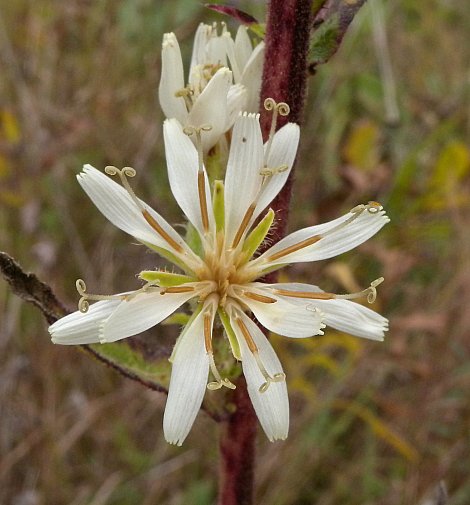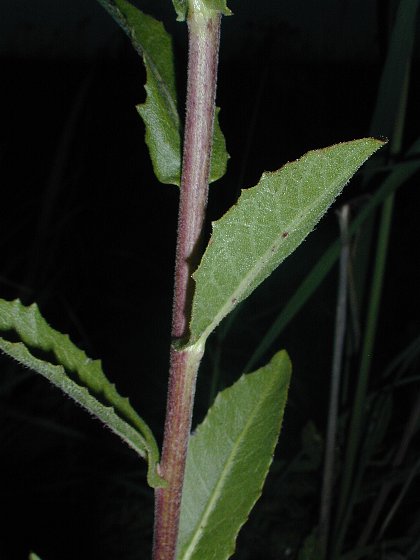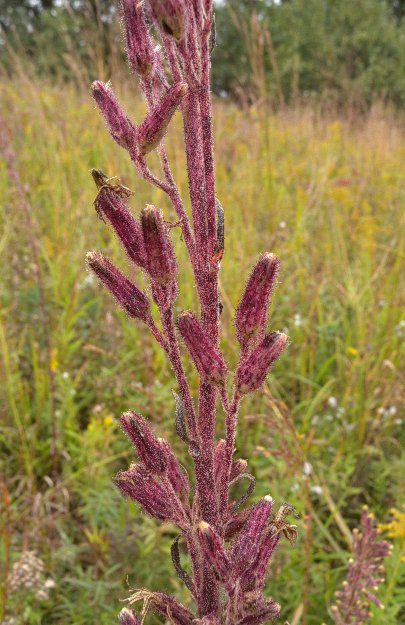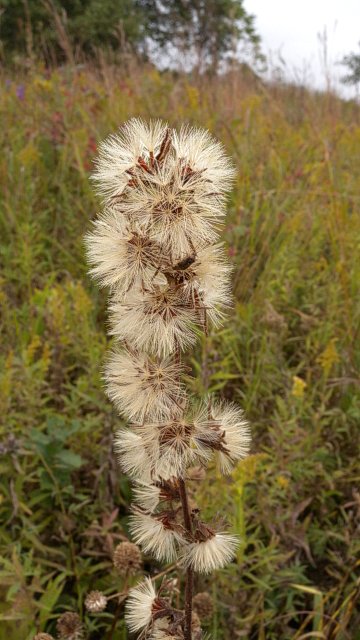Description: This herbaceous perennial wildflower is 2-5' tall with an erect central stem that is unbranched. This stem is light green, terete, stout, and covered with short stiff hairs; it often becomes brown with age. The alternate leaves are up to 4½" and 2" across, becoming gradually smaller as they ascend the stem. They are lanceolate to broadly lanceolate, elliptic, or oblanceolate in shape, medium green, and covered with short stiff hairs on their undersides. The margins of the lower leaves are dentate, while the margins of the upper leaves are more smooth. Most of the leaves are sessile, although some of the lower leaves may clasp the stem slightly; some of these leaves may wither before the blooming period. The foliage contains a bitter white latex. The central stem terminates in a spike-like raceme (or something similar to this) about ½–2' long. Along the central stalk of this raceme, are small clusters of flowerheads; small clusters of flowerheads also develop from the axils of the upper leaves.

Each flowerhead is about ½–1" across, consisting of 10-18 ray florets and no disk florets. Each of these ray florets is white or cream-colored, linear-oblong in shape, and truncate at its tip with 5 small teeth. The base of each flowerhead is about ½" long and cylindrical in shape; it is covered with 8-10 phyllaries (floral bracts) that are light green, conspicuously hairy, and linear-oblong in shape. At the bottom of the flowerhead's base, there are several secondary phyllaries that are much smaller in size and insignificant. The reproductive organs of the ray florets consist of divided styles with strongly recurved tips and elongated stamens. The blooming period occurs from late summer to early fall and lasts about 2-3 weeks. Each fertile floret is replaced by an oblongoid achene with a small tuft of hairs. These hairs are straw-colored or light brown. Distribution of the achenes is provided by the wind. The root system consists of a stout taproot that is broadest toward the middle. This plant reproduces by reseeding itself.

Cultivation:
The preference is full sun and mesic to dry conditions. Different kinds
of soil are tolerated, including those that are loamy, rocky, or sandy.
It is difficult to establish this plant from seed as it is slow-growing
and the young seedlings are vulnerable to "damping off" and other
problems.
Range & Habitat:
Rough White Lettuce exists in widely scattered populations throughout
Illinois (see Distribution
Map), where it is native. Populations of this species have
declined and it has
become rather uncommon, largely
because of the destruction of prairie habitat throughout the state.
Habitats include black soil prairies, sand prairies, savannas, rocky
upland woodlands, limestone glades, and prairie remnants along
railroads. At one time, Rough White Lettuce was considered a weed in
pastures, but this is no longer the case. Today, this conservative
species is typically found in high quality prairies. Because of the
difficulty in propagating this species, it is not often used in prairie
restorations.

Faunal
Associations:
Bumblebees visit the flowerheads for nectar, while the Pennsylvania
Soldier Beetle (Chauliognathus pennsylvanicus) probably feeds on their
pollen (Robertson, 1929; Williams, 2006). Some aphids, moth
caterpillars, larvae of gall flies, and larvae of gall wasps are known
to feed on Prenanthes
spp. (White Lettuce). Cattle and
other mammalian herbivores usually leave this plant alone because of
its rough hairy foliage and bitter latex (Georgia, 1913).
Photographic Location:
The photographs of the flowerheads, flower buds, and seedheads were
taken by the webmaster at the
Prospect Cemetery Prairie in Ford County, Illinois, while the
photograph of the stem and leaves
was taken by the webmaster at Loda Cemetery Prairie in Iroquois County
of the same state.

Comments: This is a true prairie plant that blooms during the fall. It is somewhat similar in appearance to Prenanthes racemosa (Glaucous White Lettuce), which prefers moist habitats. This latter species has a central stem that is glabrous and glaucous throughout, while the central stem of Rough White Lettuce has stiff short hairs. The color of the flowerheads is also somewhat different: the flowerheads of Glaucous White Lettuce often have a pale purple tint, while those of Rough White Lettuce are cream-colored or white. Other Prenanthes spp. in Illinois are normally found in woodlands, rather than prairies. In contrast to Rough White Lettuce, these woodland species have nodding flowerheads, more widely spreading inflorescences, and leaves that are often deeply lobed.